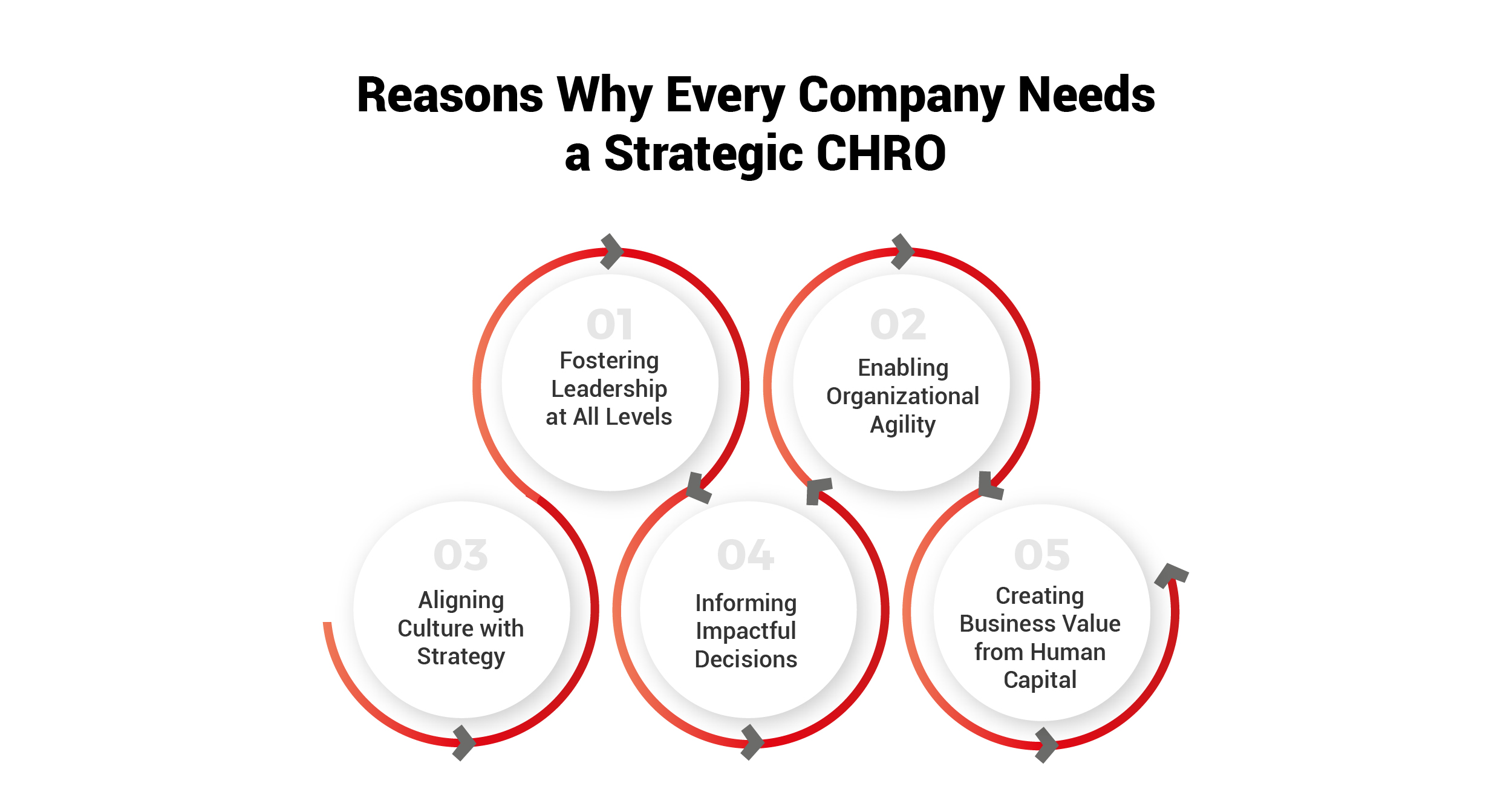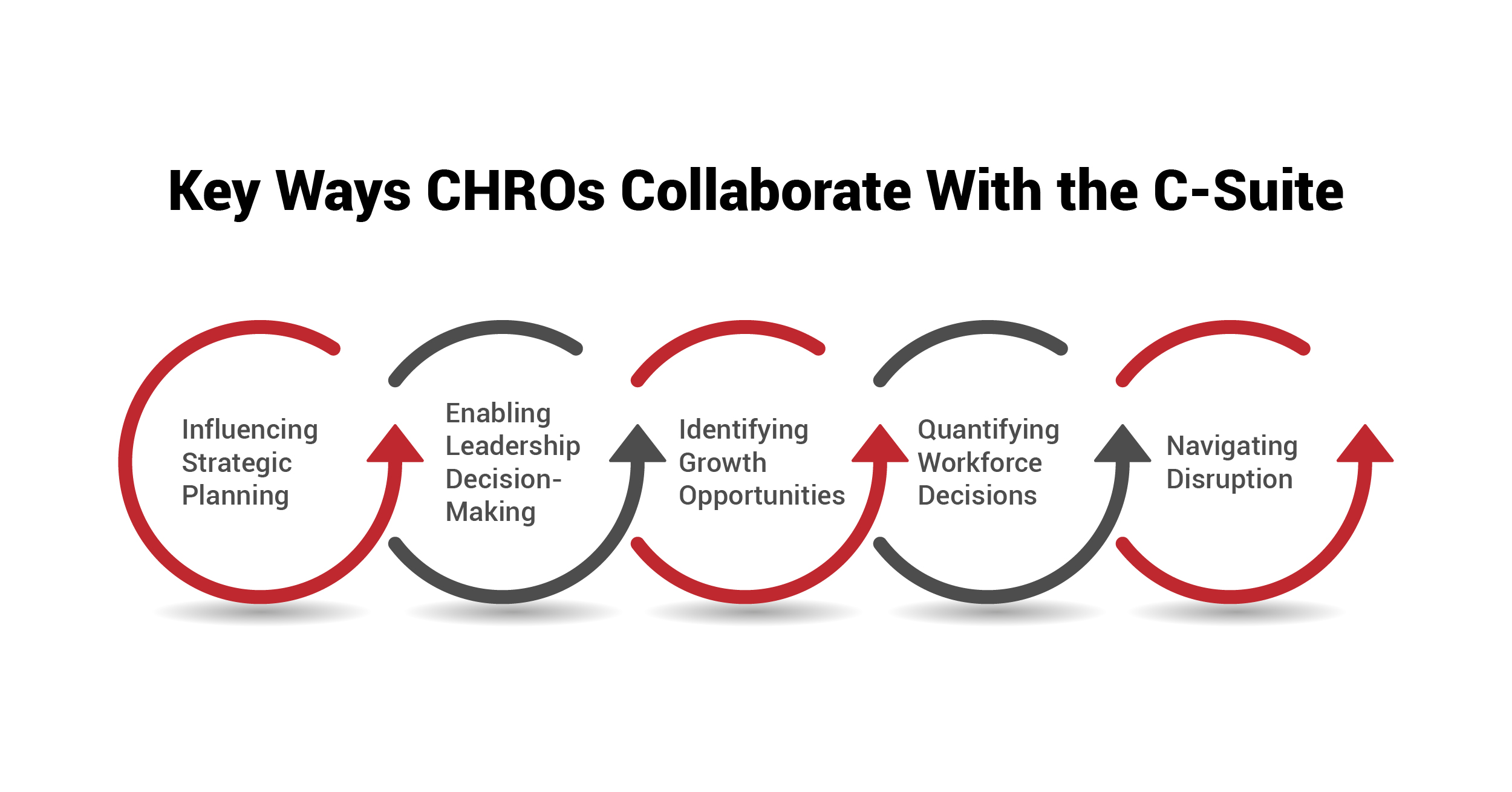As companies navigate an increasingly complex business landscape, the need for strategic leadership has never been greater. Human capital is more vital than ever in driving organizational success, which is why having a Chief Human Resources Officer (CHRO) at the leadership table is critical.
A strategic CHRO aligns talent management with long-term business goals, providing the insight and foresight to tackle disruptions. They promote a culture that empowers employees and leaders alike to innovate and adapt. By identifying needs, developing capabilities, and removing barriers, the CHRO enables an agile, future-fit workforce.
This article explores how a strategic CHRO serves as an indispensable partner to the CEO and leadership team. We’ll examine why the CHRO role has become more pivotal, what capabilities define a truly strategic CHRO, and how they collaborate with executives to shape organizational strategy.
HR has travelled a long road, from administrative overseer to strategic business enabler. The genesis of the CHRO role has accompanied this transformation, rising in prominence over the last decade.
Historically, the head of HR focused on personnel supervision, policy implementation, and business support. While essential, these responsibilities centered on organizational maintenance rather than advancement.
However, digital disruption, data proliferation, and dynamic markets have heightened the need for nimble, innovative workforces. This has thrust talent strategy into the spotlight, demanding that HR shapes business strategy instead of merely supporting it.
Hence, the Chief Human Resources Officer was born. CHROs integrate talent decisions into financial planning, provide recommendations based on workforce analytics, and enable organizational agility through culture and capabilities. Their place at the executive table signifies the mission-critical status human capital now holds.
However, the obligations of strategic influence exceed conventional HR expertise. Tomorrow’s CHROs must exert credible leadership, understand all facets of the business, and link every human capital decision to desired business outcomes.
Key reasons why every company needs a strategic CHRO at the top level include:
A strategic CHRO recognizes leadership as a core competency across the organization, not just at the executive level. They create pipelines to develop future leaders through mentorship, stretch assignments, and skills training. By propagating a culture of learning, strategic CHROs ensure sustainability through succession planning.
From pandemics to recessions, disruptions are now the norm. Strategic CHROs promote workforce agility by upskilling employees and introducing flexible arrangements. This organizational dexterity allows for rapid adaptation in dynamic markets.
Culture is instrumental in executing strategic visions. Strategic CHROs assess and reshape company culture to embody core values. This cultural stewardship then galvanizes employees around shared goals.
With access to rich workforce insights, strategic CHROs contextualize talent constraints, capabilities, and risks for business leaders. These people-focused perspectives lead to more informed, deliberate decisions by the C-Suite.
Unlike conventional HR, strategic CHROs take a business-first approach to human capital. By quantifying the impact of various talent initiatives, they provide tangible metrics on the value of workforce investments. This business acumen earns strategic CHROs that coveted seat at the leadership table.
While responsibilities differ across companies, the most effective CHROs share distinguished competencies that drive their leadership authority.
The most effective CHROs maintain strong alignment between talent management and overarching business goals. Leveraging keen business acumen and analytical skills, strategic CHROs provide the C-suite with actionable insights on optimizing human capital as a key driver of organizational strategy and performance.
With a clear understanding of commercial objectives, CHROs ensures that all workforce planning, and talent programs directly support desired business outcomes. Their grasp of organizational priorities and challenges allows them to continuously evaluate and adapt talent strategies based on emerging needs. Strategic CHROs also utilize workforce analytics to identify capability gaps, talent risks, and opportunities to strengthen competitive positioning.
By keeping a pulse on external trends, industry transformations, and internal talent dynamics, the CHRO serves as a trusted advisor to the executive team in harnessing human capital to catalyze organizational growth and innovation.
As transformation partners to both leadership and employees, highly effective CHROs play an instrumental role in guiding organizations through major change initiatives including restructures, process improvements, technology implementations, mergers and acquisitions.
With emphasis on adaptability and resilience, they prepare workforces to embrace transformations by clearly communicating the need for change, providing transitional support structures, and reinforcing new mindsets throughout the organization. During volatile shifts, CHROs maintain transparency, address uncertainties, and sustain employee motivation and engagement.
As stewards of change, CHROs also focus on embedding agility into organizational culture so that employees learn to navigate fluidity with minimal disruption. By promoting shared mindsets of evolution and growth, they build workforces that can weather ongoing change and unlock innovation.
Beyond an abstract concept, culture represents a powerful tool for strategic CHROs to unlock discretionary effort, reignite employee motivation, and reshape behaviors across organizations.
Effective culture stewards treat the reshaping of company culture as a means to drive talent innovation, collaboration, customer centricity and other strategic outcomes. This involves nurturing a shared sense of purpose, establishing clear direction, and embedding common values that bring expected behaviors and decisions in alignment.
Rather than allowing culture to go unchecked, high-impact CHROs continuously realign artifacts, mindsets and processes to catalyze organizational transformation and competitive advantage. With emphasis on transparency, accountability and consistency, CHROs enable unified cultures where priorities cascade from the top to bottom.
To promote business continuity and stability amidst market volatility or leadership transitions, strategic CHROs prioritize robust succession planning for key roles across the organization.
This involves developing hiring strategies to build leadership bench strength, creating tailored leadership development programs to accelerate high-potential employees, and using assessments to expose capability gaps. Effective CHROs also provide visibility into succession slates and leadership pipelines to the executive team.
By proactively preparing successors for critical positions, CHROs enable smooth continuity of business operations and minimize talent risks during leadership changes. Their grasp of competency models paired with data-driven insights allows for precise identification and development of next-generation leaders.
Fluency in talent analytics enables data-backed workforce insights on performance, retention risks, and capability gaps. This allows strategic CHROs to shift from rearview assessments of annual reports into predictive, actionable foresight.
Rather than relying on intuition, high-impact CHROs harness technology to derive specific talent insights that expose development areas and inform planning. Their analytical acumen is both retrospective and forward-facing to optimize current capabilities as well as competitive positioning.
With real-time access to interactive HR dashboards, CHROs identify trends, outliers and patterns across the talent lifecycle. By translating analytics into strategic opportunities and decisions, data-driven CHROs advise the executive team on mitigating emerging risks.
While best practices provide effective HR norms, the most successful CHROs realize that transformative ideas manifest through experimentation rather than replication. They introduce new systems, tools and technologies to unlock efficiency, agility and competitive advantage across talent strategies.
With an innovation mindset oriented toward continuous evolution, CHROs identify possibilities for disruption in delivering HR solutions and shaping the future workforce. By combining inventive capabilities with calculated risk-taking, they spearhead cultural change and process improvements across organizations.
Does this detailed response for each section capture what you were looking for? Please let me know if you need any clarification or have additional questions.
Far beyond administration, CHROs now create value as C-suite partners to the CEO. When collaborating with business leaders, strategic CHROs center discussions on realizing commercial outcomes through people priorities.
Here are keyways CHROs collaborate with the executive team:
Instead of merely aligning talent strategy to business strategy, CHROs actively shape strategic planning through human capital insights. By spotlighting capability gaps, investment tradeoffs, and emerging risks, they provide the workforce context for planning.
With a singular view into the organization’s human fabric, CHROs contextualize problems for business leaders to drive solutions. Their real-time pulse on employee sentiment, capability gaps, and team dynamics enrich leadership decision-making.
Talent powers innovation. Strategic CHROs apply workforce analytics to identify pockets of untapped potential across the company. By highlighting these hidden growth opportunities, they point business leaders toward value creation.
All talent investments must ultimately serve the company’s profit engine. Strategic CHROs quantify the business impact of their programs to procure executive buy-in. This data-driven approach prioritizes workforce spend based on tangible ROI.
When volatility strikes, CHROs partner with executives to guide the workforce through uncertainty. They provide stability and direction through transparent communication, rapid upskilling, and culture resetting.
Rising revenue targets, remote work trends, automation technologies – the forces shaping business demand strategic prowess from HR leaders.
As organizations realize their greatest asset remains their people, there is a clarion call to elevate the CHRO role. Executive teams can no longer afford talent strategies that align merely with current objectives but rather must forecast workforce needs for future success.
This means pursuing not just any HR executive, but a strategic leader who provides the foresight and influence to unleash human potential. With the right capabilities, credibility, and business aptitude, the CHRO can architect workforces that sustain competitive advantage.
For forward-thinking companies, integrating the CHRO into strategic leadership is non-negotiable. As the global talent market grows more complex, this partnership will separate the organizations that power ahead from those left behind.
This website uses cookies to enhance website functionalities and improve your online experience. By browsing this website, you agree to the use of cookies as outlined in our privacy policy .